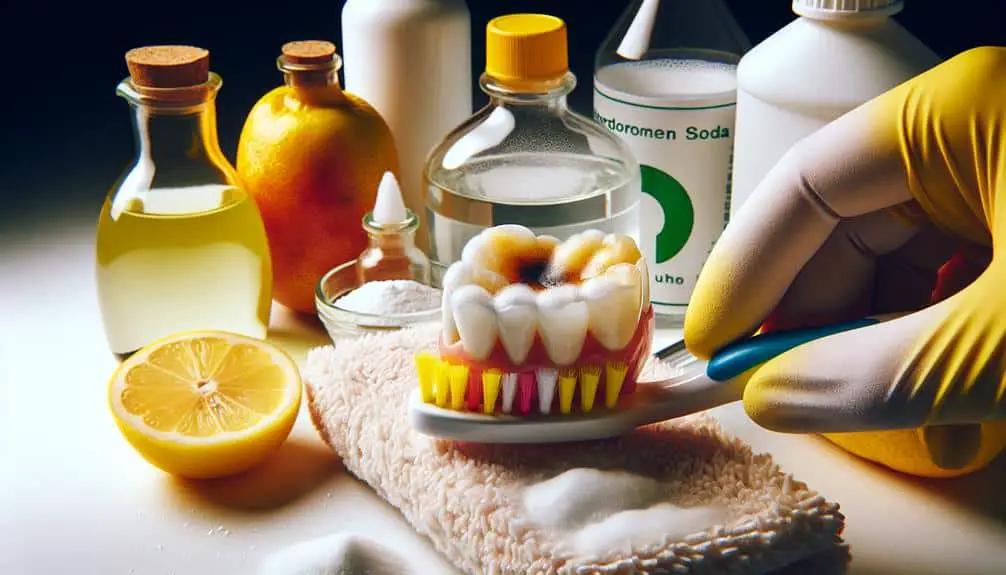To effectively combat tetracycline stains, combine professional whitening treatments, home remedies, and over-the-counter products. Try microabrasion, bonding, veneers, or crowns for stubborn stains. Consider in-office whitening for quick results or customized at-home kits. Natural remedies like baking soda and hydrogen peroxide may help. Over-the-counter options like whitening strips or trays can gradually reduce stains. Maintain results with daily brushing, flossing, and regular dental check-ups. Limit staining foods and rinse after consuming. Different strategies work best for different levels of staining.
Key Points
- Professional treatments like microabrasion and veneers effectively remove tetracycline stains
- In-office whitening with high-concentration bleaching gel offers quick and noticeable results
- Natural remedies like baking soda can help lighten tetracycline stains over time
- Over-the-counter whitening products such as whitening strips can gradually lighten stains
- Consistent maintenance with whitening toothpaste and regular dental check-ups is crucial
Understanding Tetracycline Stains
To understand tetracycline stains, it's imperative to explore the mechanism by which these discolorations occur on teeth. Tetracycline, an antibiotic, can bind to the calcium ions in developing teeth, causing them to become discolored with a range of hues, from yellow to dark brown or gray. This discoloration typically happens during tooth development in childhood, resulting in permanent stains that can be challenging to remove.
The causes of tetracycline stains lie in the incorporation of the antibiotic into the tooth structure during the formative years. Due to this internal nature of the discoloration, surface treatments like traditional whitening methods are often ineffective in fully eliminating tetracycline stains. However, there are effective treatments available, such as microabrasion, composite bonding, veneers, and crowns. These methods can help cover or remove the discolored areas, providing solutions for those seeking to address tetracycline stains and improve the aesthetics of their smiles.
Professional Whitening Options
Consider exploring various professional whitening options to effectively address tetracycline stains and enhance the brightness of your teeth. In the world of cosmetic dentistry, teeth whitening procedures offer a vital solution to combat stubborn tetracycline stains. Professional teeth whitening treatments conducted by experienced dentists can greatly reduce the appearance of these challenging stains.
One popular professional whitening option is in-office teeth whitening, where a high-concentration bleaching gel is applied to the teeth and activated by a specialized light to accelerate the whitening process. This method guarantees quick and noticeable results in just one visit. Additionally, dentists may recommend at-home whitening kits customized to fit your teeth, providing a convenient way to maintain and enhance the effects of in-office treatments.
Consulting with a dental professional specializing in cosmetic dentistry is essential to determine the most suitable whitening option for your specific needs. With the advancements in teeth whitening technology, achieving a brighter, stain-free smile is now more attainable than ever before.
Home Remedies for Stain Removal
Exploring home remedies for stain removal can be a cost-effective and natural alternative to professional whitening options for addressing tetracycline stains on your teeth. When dealing with tetracycline stains, natural remedies can offer a gentle yet effective way to lighten discoloration. One popular DIY solution is baking soda mixed with hydrogen peroxide to form a paste. This mixture can be applied to your teeth, gently scrubbed for a few minutes, and then rinsed thoroughly. The mild abrasive nature of baking soda combined with the whitening properties of hydrogen peroxide can help diminish the appearance of tetracycline stains over time.
Another common home remedy involves using lemon juice as a natural bleaching agent. However, using this method sparingly is crucial as the acidity of lemon juice can potentially erode tooth enamel with frequent use. Turmeric mixed with coconut oil is also believed to have stain-lifting properties and can be used as a natural toothpaste alternative.
Over-the-Counter Whitening Products
When looking to address tetracycline stains on your teeth, exploring over-the-counter whitening products can provide convenient and effective solutions. Toothpaste alternatives specifically designed for whitening can be a good starting point. These toothpaste options often contain gentle abrasives or polishing agents that help remove surface stains, including those caused by tetracycline. It's important to use them consistently for best results.
DIY solutions are also popular among individuals seeking to whiten teeth at home. Whitening strips are a common choice and are easy to use. These strips are coated with a whitening gel containing peroxide, which helps to lighten stains on the enamel. Another option is whitening trays, which are filled with a whitening gel and molded to fit your teeth. These trays are worn for a specified period, usually before bedtime, and can gradually lighten tetracycline stains.
When considering over-the-counter whitening products, be sure to follow the instructions carefully to avoid any potential side effects and to achieve the most favorable results.
Maintenance Tips for Lasting Results
For long-lasting results after using over-the-counter whitening products to address tetracycline stains on your teeth, incorporating effective maintenance tips is vital. To prevent the recurrence of tetracycline stains and maintain your bright smile, consider implementing some key prevention tips. To start, make sure you brush your teeth at least twice a day with a whitening toothpaste containing fluoride to help prevent new stains from forming.
Flossing daily is also essential to remove plaque and prevent discoloration between teeth. Additionally, regular dental check-ups and professional cleanings can help identify and address any staining early on.
Diet control is another important aspect of maintaining your results. Avoid or limit consumption of foods and drinks that are known to cause staining, such as coffee, tea, red wine, and dark berries. If you do indulge in these items, consider rinsing your mouth with water afterwards to help minimize their staining effects. By following these maintenance tips and being mindful of your diet, you can enjoy lasting results from your tetracycline stain removal efforts.
Frequently Asked Questions
Can Tetracycline Stain Removal Techniques Be Harmful to Enamel or Cause Tooth Sensitivity?
When removing tetracycline stains, ensuring enamel protection and sensitivity prevention are essential. Techniques that are overly abrasive or harsh may harm enamel or lead to tooth sensitivity. Gentle methods and professional guidance are key.
Are There Any Specific Foods or Drinks That Should Be Avoided to Prevent Future Tetracycline Staining?
To prevent future tetracycline staining, avoid foods and drinks like coffee, tea, red wine, and dark sodas that can lead to discoloration. Incorporate stain-preventing measures by maintaining good oral hygiene and considering dietary restrictions for long-term enamel health.
How Long Does It Typically Take to See Results From Professional Whitening Options for Tetracycline Stains?
To see results from professional whitening for tetracycline stains, it may take several sessions. Progress varies based on stain severity and individual response. Long-term outcomes depend on maintenance and lifestyle choices. Consistent care is key.
Are There Any Alternative Treatments or Procedures for Tetracycline Stains Besides Whitening?
When dealing with tetracycline stains, consider natural remedies, laser therapy, cosmetic dentistry, and microabrasion techniques as alternative treatments. These options offer varied approaches for addressing stubborn discoloration beyond traditional whitening methods.
Is It Possible for Tetracycline Stains to Return After Undergoing Stain Removal Techniques?
Stain recurrence after tetracycline stain removal techniques is possible due to the nature of the medication's impact on tooth structure. Long term effects can include reoccurrence risks, emphasizing the importance of stain prevention through proper dental care.



